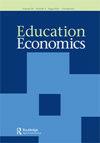哪些类型的大学能增加收入?根据地理邻近度估算
IF 0.9
Q3 Social Sciences
引用次数: 0
摘要
摘要高等教育机构为什么会产生不同的劳动力市场结果这个问题很难回答,因为没有观察到学生的特征。在这里,我利用学生在地理上接近三种高等教育机构——提高收入、竞争和传统黑人学院和大学(HBCUs)。使用一个具有全国代表性的样本,我估计了首次参加每种类型的成就和收入效应。进入一所被归类为提高收入的院校就读,可以提高人文学科学分的完成程度、学位的获得程度和早期职业生涯的工资。在代表性不足的学生中,住得离HBCU最近强烈地预示着HBCU的入学率。这导致更高的STEM学分完成率,但较低的早期职业工资,表明可能存在劳动力市场偏见。竞争性:Barron's Top 3 Selectivity Tier Institution;HBCU:历史上的黑人学院或大学;恒生指数:高成功机构;茎:科学;技术;工程;和数学;少数族裔(URM):黑人;本土的;最近的大学属性预测了许多高中生的大学选择,尤其是那些住在hbcu附近的学生。以前与学生工资流动性挂钩的大学在学生25岁左右的时候收入更高。较高的收入效应与较高的人文学科学分完成度、学士学位完成度和学士学位后培训相吻合。与其他选择相比,就读HBCU的学生可以获得更高的STEM学分,但较低的早期职业工资。HBCU的出勤率相对于没有大学的人也增加了人文学科学分的完成率和学士学位的完成率。关键词:人力资本工资工资差异制度效应工具变量大学接近性披露声明作者未报告潜在利益冲突。注1 Chetty等人(Citation2017)还发现,院校的“流动性”存在很大差异,他们将其定义为院校的成功率与最低五分之一的学生入学比例的乘积ELS:2002提供了每个学校和学生的横截面基年权重,以反映从抽样设计中已知的选择的逆概率,以及从基线时的学生和学校属性估计的无响应概率。该数据集还包括用于其他调查波的纵向分析的面板权重。我没有在这个分析中使用ELS权重,因为我的识别策略,工具变量分析,实际上给那些对地理工具变量集敏感的受访者分配了更大的权重。因此,应用抽样和非响应权重可能会扭曲IV分析的内部有效性(Solon, Haider, and Wooldridge Citation2015)同样被列为高成功院校的四所hbcu分别是霍华德大学、莫尔豪斯学院、斯佩尔曼学院和路易斯安那州泽维尔大学。4我也尝试过进入一所高stem院校,但这组地理指标并不能预测我能否进入这类院校。本文章由计算机程序翻译,如有差异,请以英文原文为准。
Which college types increase earnings? Estimates from geographic proximity
ABSTRACTThe question of why postsecondary institutions produce different labor market outcomes is difficult to answer due to unobserved student characteristics. Here, I leverage students' geographic proximity to three classifications of postsecondary institutions – earnings-enhancing, competitive, and Historically Black Colleges and Universities (HBCUs). Using a nationally representative sample, I estimate attainment and earnings effects of first attending each type. Attending an institution classified as earnings-enhancing increases humanities credit completion, degree attainment, and early-career wages. Among underrepresented students, living closest to an HBCU strongly predicts HBCU enrollment. This yields higher STEM credit completion but lower early-career wages, suggesting possible labor market bias.Abbreviations: Competitive: Barron's Top 3 Selectivity Tier Institution; HBCU:Historically Black College or University; HSI: High-Success Institution; STEM: Science; Technology; Engineering; and Mathematics; Underrepresented Minority (URM): Black; Indigenous; or Hispanic/LatinxHIGHLIGHTSNearest-college attributes predict college choice for many high school students, especially those living near HBCUs.Colleges previously linked to students' wage mobility yield higher earnings by students' mid-20s.Higher earnings effects coincide with higher humanities credit completion, bachelor's completion, and postbaccalaureate training.HBCU attendance relative to other options yields higher STEM credit completion, but lower early-career wages.HBCU attendance relative to no college also increases humanities credit completion and bachelor's degree completion.KEYWORDS: Human capitalsalary wage differentialsinstitutional effectsinstrumental variablescollege proximity Disclosure statementNo potential conflict of interest was reported by the author.Notes1 Chetty et al. (Citation2017) also found high variation in the ‘mobility rates’ of institutions, which they defined as the product of institutions' success rates and the fraction of bottom-quintile students enrolled in them.2 ELS:2002 provides cross-sectional base-year weights for each school and student to reflect both the inverse probability of selection, which is known from the sampling design, and the probability of nonresponse, which is estimated from student and school attributes at baseline. The dataset also includes panel weights for use in longitudinal analyzes across the other survey waves. I do not employ the ELS weights in this analysis because my identification strategy, instrumental variables analysis, in effect assigns greater weight to respondents who are sensitive to the set of geographic instrumental variables. Applying sampling and non-response weights may therefore distort the internal validity of the IV analysis (Solon, Haider, and Wooldridge Citation2015).3 The four HBCUs also classified as high-success institutions are Howard University, Morehouse College, Spelman College, and Xavier University of Louisiana.4 I attempted to instrument for entry into a high-STEM institution as well, but the set of geographic instruments did not predict entry into this type of institution.
求助全文
通过发布文献求助,成功后即可免费获取论文全文。
去求助
来源期刊

Education Economics
EDUCATION & EDUCATIONAL RESEARCH-
CiteScore
2.00
自引率
8.30%
发文量
38
期刊介绍:
Education Economics is a peer-reviewed journal serving as a forum for debate in all areas of the economics and management of education. Particular emphasis is given to the "quantitative" aspects of educational management which involve numerate disciplines such as economics and operational research. The content is of international appeal and is not limited to material of a technical nature. Applied work with clear policy implications is especially encouraged. Readership of the journal includes academics in the field of education, economics and management; civil servants and local government officials responsible for education and manpower planning; educational managers at the level of the individual school or college.
 求助内容:
求助内容: 应助结果提醒方式:
应助结果提醒方式:


